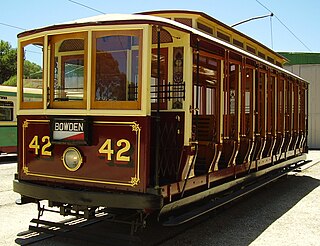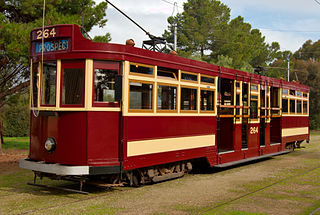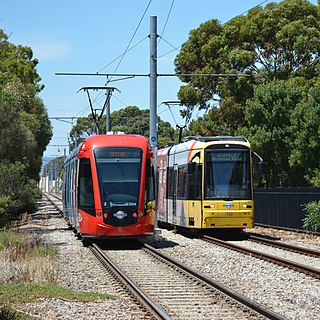
Adelaide Metro is the public transport system of the Adelaide area, around the capital city of South Australia. It is an intermodal system offering an integrated network of bus, tram, and train services throughout the metropolitan area. The network has an annual patronage of 79.9 million, of which 51 million journeys are by bus, 15.6 million by train, and 9.4 million by tram. The system has evolved heavily over the past fifteen years, and patronage increased dramatically during the 2014–15 period, a 5.5 percent increase on the 2013 figures due to electrification of frequented lines.

Melbourne tram route 96 is operated by Yarra Trams on the Melbourne tram network from Brunswick East to St Kilda Beach. The 13.9 kilometre route is operated out of Southbank depot with C2, E class, and on occasion A class trams.

The Glenelg tram line is a tram/light rail line in Adelaide. Apart from a short street-running section in Glenelg, the line has its own reservation, with minimal interference from road traffic.

The State Transport Authority (STA) was the government agency which controlled public transport in South Australia between 1974 and 1994.

The Municipal Tramways Trust (MTT) was established by the Government of South Australia in December 1906 to purchase all of the horse-drawn tramways in Adelaide, South Australia. The Trust subsequently also ran petrol and diesel buses and electric trolleybuses. It ceased to exist on 8 December 1975, when its functions were transferred to the State Transport Authority, which also operated Adelaide's suburban train services.

St Kilda is a coastal township, now classed as a suburb, 21 kilometres north-north-west of the centre of Adelaide, capital city of South Australia. With a population below 100 and a sole 4-kilometre (2.5-mile) road connecting to the nearest highway, its natural and built resources have remained relatively undisturbed. The seafront, containing a large area of mangroves, faces the Barker Inlet, which is part of the Port River estuarine area. St Kilda is an internationally recognised bird-watching area: more than 100 species of birds feed in and around the mudflats, salt lagoons, mangroves and seagrass beds.

Until 1958, trams formed a network spanning most of Adelaide, South Australia, with a history dating back to 1878. Adelaide ran horse trams from 1878 to 1914 and electric trams from 1909, but has primarily relied on buses for public transport since the mid-20th century. Electric trams, and later trolleybuses, were Adelaide's main method of public transport throughout the life of the electric tram network. The tram network was progressively closed down through the 1950s with the last lines closing in 1958; the Glenelg tram line was the only line to survive these closures and has remained in operation ever since and has been progressively upgraded and extended since 2005.

The earliest trams in Australia operated in the latter decades of the 19th century, hauled by horses or "steam tram motors". At the turn of the 20th century, propulsion almost universally turned to electrification, although cable trams lingered in Melbourne. In cities and towns that had trams, they were a major part of public transport assets.

The H type Adelaide tram was a class of 30 trams built by A Pengelly & Co, Adelaide in 1929 for use on the newly constructed Glenelg tram line. They remained in regular revenue service until replaced by Bombardier Flexity Classic trams in 2006.

The Adelaide trolleybus system formed part of the public transport network in Adelaide, South Australia from 1932 until 1963.
The O-class Melbourne tram were a group of four trams built in 1912 by Duncan & Fraser (Adelaide) for the Prahran & Malvern Tramways Trust (P&MTT) upon the recommendation of W. G. T. Goodman, Chief Engineer and General manager of the Adelaide tramways. They were allocated P&MTT fleet numbers 21 to 24. At the time of their introduction, they were by far the largest street-vehicles in Melbourne, and earned the nicknames Zeppelins and Dreadnoughts. Proving to be less than satisfactory in service, they were later sold to the Hawthorn Tramways Trust (HTT) in August 1916 as "surplus to requirements", however P&MTT soon ordered replacement tramcars. Coincidentally they retained their fleet numbers whilst at Hawthorn.
This article describes the tram types in Adelaide that have operated for the past 145 years: from early days when they undertook a major share of the public transport task before car ownership was well established; through the 49-year period when only one tram line operated; to the city's 21st-century tramways revival.

The B type Adelaide tram was a class of 30 straight sill, open cross-bench trams built by Duncan & Fraser, Adelaide in 1909 for the Municipal Tramways Trust (MTT). Although popular in summer, they were less so in winter when exposed to inclement weather. Thus in 1917 with the MTT requiring more trams, 41-60 were converted to Californian combination trams, closely resembling the A type trams. When the MTT introduced an alpha classification system in 1923, they were designated the B type. Numbers 41-43 became the A2 type and 44-60 the A1 type. The A2s were used exclusively on the isolated Port Adelaide network.

The C type Adelaide tram was a class of 20 drop end, California combination trams built by Duncan & Fraser, Adelaide in 1918 for the Municipal Tramways Trust (MTT). All were delivered in 1918, but as they were receiving second-hand motors from the E type trams, the last did not enter service until September 1919. When the MTT introduced an alpha classification system in 1923, they were designated the C type.
The Adelaide D type tram was a class of trams operated by the Municipal Tramways Trust on the Adelaide tram network from 1910 until 1958.

The F type Adelaide tram was a class of 84 bogie, drop centre, combination trams built between 1921 and 1929 for the Municipal Tramways Trust (MTT). All bar three were built by A Pengelly & Co, Adelaide with 262, 283 and 284 being built by the MTT's Hackney workshops. The first 50 were built as the F type, while the last 34 were classified as the F1 type, the latter having an all steel as opposed to partly wooden underframe. Some remained in service until the network closed in November 1958.

The H1 type Adelaide tram was a one-off tram built by JA Lawton & Sons in 1952 for the Municipal Tramways Trust (MTT), Adelaide.
The Melbourne tram network began in 1884 with the construction of the Fairfield Horse Tramway. However, the purpose of the line was to increase land prices in the area, and it soon closed during the depression in 1890. The first genuine attempt to construct a tramway network was the construction of the Richmond cable tram line by the Melbourne Tramway & Omnibus Company in 1885. Over the next few years, 16 more cable tram lines were constructed, as well as numerous other horse tramways. The depression of the early 1890s slowed further expansion of the cable network. The first electric tram line was the Box Hill and Doncaster tramway which opened in 1889. This was a pioneering line in what was then the countryside and thus didn't receive much patronage. It closed in 1896. The next attempt at an electric tramway was Victorian Railways' St Kilda to Brighton line, which opened in 1906. Later that year, the North Melbourne Electric Tramway & Lighting Company opened lines to Essendon and Maribyrnong. Many local councils formed their own tramway trusts and built tramways within their own constituency. The most successful of these was the Prahran & Malvern Tramways Trust.

This article – one of several about Adelaide’s tramways – covers the three decades before the 1910s when horses provided the motive power for all trams over a 74 miles network. Links to an overview and other articles are in the following panel.

This article – one of several about Adelaide’s trams – describes the development of new lines and operation of new trams since 2005. Links to an overview and other articles are in the following panel.




































